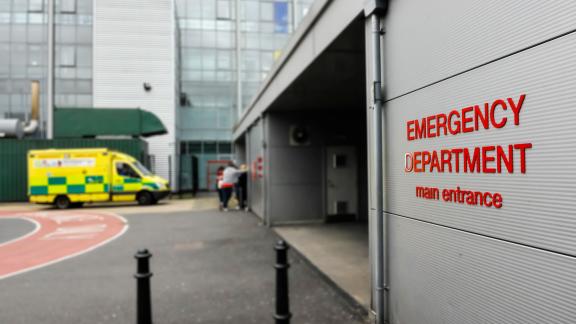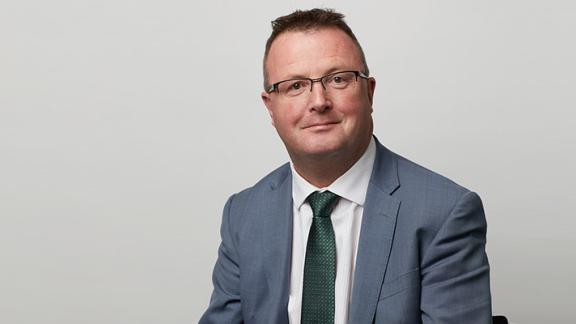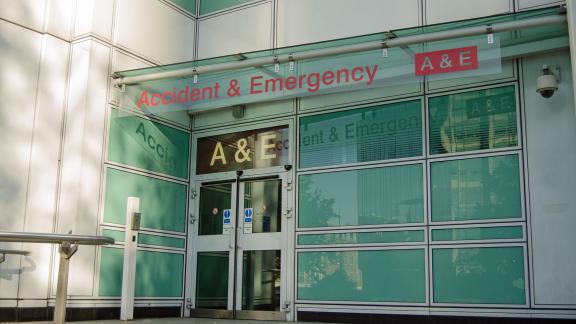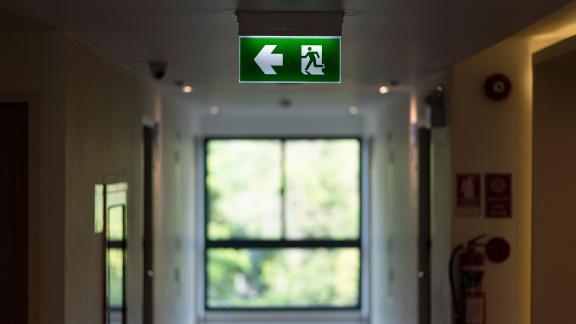Analysis: November release of NHS performance statistics

At a glance
- The challenge in urgent care is huge, with ambulance and major A&E demand increasing in October to hitherto unseen levels, including the highest volume of 999 calls on record. Alongside this, the data shows unprecedented levels of A&E waits and record high lengths for ambulance response times, amid concerning reports of high volumes of ambulance handover delays.
- Despite the NHS seeing 1.3 million people who have been waiting for planned care in September, the elective backlog has continued to grow reaching a new peak of 5.83 million patients.
- Numbers of both 52- and 104-week waiters have increased, a challenging picture in the context of recent planning guidance to stabilise 52-week waiters and eradicate the number of people waiting 104 weeks. High volumes of patients are now crossing both thresholds and we are likely to soon see a statistical bulge of long waiters who joined the list early in 2020.
- COVID-19 cases are just one of the factors driving the pressures in the health system this winter but can disproportionately affect available capacity due to the additional infection control measures required. We can see that hospitalisations in England have fluctuated over the last few weeks, reaching a peak in mid-October. COVID-19 bed occupancy has followed a similar pattern with bed occupancy peaking at the start of November and fortunately decreasing over the last week.
- Primary care continues to work tirelessly to meet the challenges of high demand pressure, seeing an estimated 28.5 million patients in September. This includes urgent care demands, with our members reporting demand for same-day appointments is currently far outstripping capacity.
COVID-19 context
Hospitalisations rose from a seven-day average of 566 per day in late September* to 871 per day in late October. These have since started to decline in November following the decrease in cases, with the number of hospitalisations dipping below 700 on 5 and 6 November and COVID-19 bed occupancy at 6,961 on 10 November. The figure of 7,535 on 1 November was the highest since March but has started to decline over the last week.
The following chart shows the increases that different regions have seen over the last two months, including the uneven rises in COVID-19 positive patients across October:
The challenges in urgent care and bringing down the waiting list shown in today’s performance figures are still exacerbated by COVID-19, even if the promising downward trend continues, as outlined in our explainer published in the summer. Due to stepped-up infection prevention, the need to split intensive care wards into different areas for positive and negative patients and added time to take on and off PPE, available beds and available time can be reduced significantly. We have also seen examples where whole wards are rendered as COVID-19 positive patients only, meaning one positive admission can change a ward of 24 available for elective patients to zero.
*The Gov.uk COVID-19 dashboard calculates seven-day average by combining that day’s data with the previous three days and the following three days, with the average of all seven days' figures is presented. The average is only calculated where the data is complete for the subsequent three days.
Urgent care challenges
A&E
Emergency departments have seen unprecedented demand throughout 2021, and this continues to be evidenced in October’s data. Both type 1 A&E attendances (major A&E departments that provide a consultant-led 24-hour service with full facilities for resuscitating patients) and total A&E attendances exceed levels previously seen for October, at 1,419,072 and 2,167,480 respectively, with the former trending above previous years across the whole summer. This is at a time where enhanced infection control measures have needed to remain in place, and you can see the comparatively low levels of attendances when the service battled COVID-19 in 2020 compared to this year:
Concerningly, the number of people waiting over four hours from ‘decision to admit’ to admission, which was already at a record level, continues to rise. In October, 121,251 patients waited over four hours, eclipsing the previous record of 104,875 which was only set in September. For context, this is only the third time this number has gone over 100,000 since records started to be recorded in this way in August 2010: one of those times was in September 2021 and one in January 2020. In October 2019 the number was 80,091, with 2,170,885 total attendances (comparable to the 2,167,480 total attendances in October 2021, albeit without the additional elective and COVID-19 challenges).
Further to this, 7,059 patients waited 12 hours from decision to admit to admission, up from the record of 5,025 the previous month. In October 2019 this was 725 patients, and this had not been over 3,000 in the figures before the pandemic (November 2020, December 2020, September 2021).
Urgent care demand is having an impact across the whole system. For instance, primary care continues to experience high demand for its urgent, same-day appointments. Although data across primary care is not uniform, our members tell us that demand for these appointments far outstrips capacity. Much of primary care is struggling to meet the urgent care needs at the same time as managing their other pressures.
Ambulance
- Demand on the ambulance service is still extremely high. Answered 999 calls in October 2021 were at their highest level ever at 1,012,143, passing the previous record of 1,003,799 which was only set in July this year and the only other time the figure has been over 1 million. This is an increase over 65,000 just on the previous month, and for context, the figure was 787,440 in October 2019 (meaning a 28.5 per cent increase from the same month two years ago).
- 999 calls answer time is averaging 56 seconds compared with the average time across all of 2020/21 of five seconds. The worst on record was previously 49 seconds, in March 2020 when the pandemic began.
- There were 82,129 C1 incidents, up from 76,123, and the C1 average response time was nine minutes 20 seconds (life threatening incident where there is a need for immediate intervention and/or resuscitation such as a cardiac arrest). The target is a seven-minute average, and in 2019 the average month was seven minutes and 12 seconds, so this is considerably higher. However, the number of incidents (an average of less than 60,000 per month in 2019, in comparison to 82,129) was much higher.
- There were 422,566 C2 incidents, up from 404,433 in September, and the average C2 response time was 53:54 a record length of time and the first time this has been over 50 minutes since the way incidents were graded in 2017 was changed. C2 incidents are emergency incidents where rapid assessment and/or urgent transport is required, and the target is an 18-minute average. The last time this was met was July 2020, with an average for 2021 of 32:06.
**C1 incidents are where an immediate response to a life-threatening condition is required, such as cardiac or respiratory arrest.
**C2 incidents are emergency incidents where rapid assessment and/or urgent transport is required.
Mental health
Demand for mental health support in all ages continues to be very high. 1.47 million people were in contact with mental health services in August 2021, which is the same as in July 2021, but still higher than previous months. The vast majority were adults, but 331,912 were children and young people (CYP). There are 1.6 million people on waiting lists for mental health care. There were also 172,838 people in contact with learning disabilities and autism services in August 2021, which is up from 169,934 in July 2021.
We hear from our members that it is not just the increase in demand, but also the higher acuity of cases that is really challenging. There were 538 urgent cases for CYP completing eating disorder pathways in July-September 2021, compared to 318 in April-June 2019. The number of CYP waiting more than one week for urgent referral due to eating disorders continues to rise, with 158 in July-September 2021 compared to 145 in April-June 2021. Between June and August 2021, there were 7,185 referrals concerning children and young people with eating disorders. Some of these children and young people will require admission to hospital, often in an acute paediatric bed.
There were 5,255 emergency referrals to crisis care teams for all ages in August 2021, down from 5,685 emergency referrals in July. Most were for adults, but 411 were for CYP. The number of emergency referrals to crisis care teams for CYP, is down from 721 referrals in July 2021.
There were 18,332 urgent referrals to crisis care teams in August 2021, down from 20,158 in July 2021. Most of the referrals are for adults and continues to be higher in this age group compared to pre-pandemic levels with 17,017 urgent referrals in August 2021 compared to 16,056 in December 2019.
A national ambition is to eliminate the number of inappropriate out-of-area placements (OAPs) for adults. The number of OAPS is still high, and in August 2021, there were 615 such placements, which is slightly down from 645 in July 2021. This commitment was set before the pandemic, and there have been data collection and data quality issues as a result.
*CYP is up to the 18th birthday.
Elective activity
The waiting list of all patients waiting for elective procedures continues to grow, rising to 5.83 million (up until the end of September) from a previous high of 5.72 million in August
There were 1.63 million new referral-to-treatment (RTT) periods (people joining the waiting list) in September. Much like last month, this is still trending below pre-pandemic levels – across 2019 the average new referral-to-treatment periods was 1.68 million. This suggests the missing patients who did not seek treatment during the pandemic are not yet returning.
In comparison, there were 1.29 million clock stops (patients who either had inpatient admissions, non-admitted pathways, such as outpatient care, or a smaller number of cases where there was a decision not to proceed with further treatment).
For 52-week waiters, the number has risen from 292,138 to 300,566, the first increase since March. It is important to note that lower levels of activity throughout the early part of the pandemic in 2020 means fewer patients were joining the queue, but this number is starting to increase considerably. In fact, more waiters over 52 weeks had their clock stopped in September (52,958) than August (45,802).
More substantial numbers of patients are also tipping over the 104-week wait threshold, with the number of people waiting 104 weeks now 12,491 rising from 9,754in August. 5,731 patients had been waiting between 100 and 104 weeks when the August stats were released last month, with 7,073 more patients due to rise over 104 weeks in the next four weeks.
This rise in 104-week waiters (and patients close to 104 weeks) present a challenge in light of the aim to eradicate 104-week waiters by March 2022 in line with recent planning guidance. Patients waiting approximately 78 weeks or more would cross this 104-week threshold by 31 March, that means treating 123,379 patients. An additional challenge here is that a high percentage of people waiting are accounted for by a small number of trusts (the top ten have over 50,000 patients, based on 78-week+ waiters).
Pressure point: primary care
Last month, NHS Digital estimated that 28.5 million GP appointments happened in September, a rise from 25.5 million in August and higher than the 26.7 million in September 2020 and the 26 million in September 2019, pre-COVID-19. Of the 28.5 million, 0.6 million were COVID-19 vaccinations; this is in comparison to the highest month of the year so far (May 2021) in which 31.6 million appointments were estimated, but 8 million were Covid vaccinations. This shows September having a much higher volume of ‘business as usual’ appointments.
This is on top of the same day, urgent care that GPs are providing. One practice manager told us that 70 per cent of the calls to their practice were for same day urgent care, with demand outstripping capacity.
552,868 vaccinations were also completed by general practice in September, with 43,987,012 completed since December 2020 according to the COVID-19 vaccination appointments (NIMS) dataset.
How is the NHS performing?
View our analysis of the latest NHS performance figures for a rounded view of how healthcare services are coping under immense pressure.



